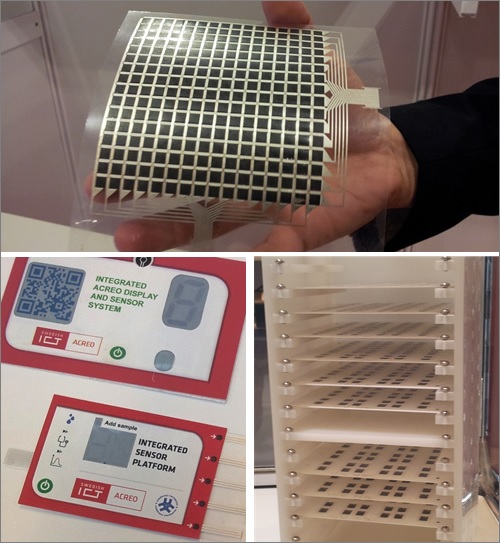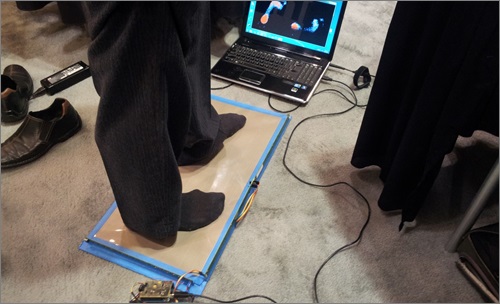Prime
time for printed sensors
The printed electronics industry shows a huge interest in sensors as it seeks
to forget the failures from the past.
 By Dr Guillaume Chansin
By Dr Guillaume Chansin
Senior Technology Analyst
IDTechEx
Two years ago I started covering the topic of printed and flexible sensors.
Since then I have been visiting companies, taking pictures of new devices at
tradeshows, and generally keeping my finger on the pulse.
Combined with our team's extensive research on printed electronics, this work
led to the publication of a market report, which quickly became one of our
bestsellers. The feedback so far has been overwhelmingly positive and we have
discovered that many companies want to understand the opportunities in printed
sensors. After listening to their requests the new edition, Printed and Flexible Sensors 2015-2025: Technologies, Players, Forecasts now
contains more detailed forecasts and more company profiles.
But why is there such an interest in printed sensors?
There are two driving forces behind this trend. The first one is history.
When I explain printed electronics, I like to distinguish between the old
printed electronics and the new one. A decade ago, people were trying to
replace silicon by organic semiconductors - materials that could be directly
printed. This idea that you could make transistors in a roll-to-roll fashion
just like a newspaper was ambitious, to say the least. Most people in the
industry now would agree that this agenda was too heroic.
Nowadays, printed electronics encompass a larger variety of materials and
devices. The objective is no longer to replace silicon but to complement it by
offering new functionalities. Sensors are particularly attractive because they
usually have a simple structure, which makes manufacturing easier. Some
companies who have accumulated a great amount of expertise in printed
electronics are now looking at sensors as their best chance to make money.

Fig 1. Various examples of printed sensors demonstrated at events (Photo: G.
Chansin)
The second driver is the gold rush for new sensor technologies for two of
today's hottest topics: wearable technologies and the Internet of Things (IoT).
In both types of applications, the sensor is the component that generates
meaningful data and therefore justifies the whole infrastructure and ecosystem.
Without sensors, it just would not make sense to connect everything around us
to the cloud.
In wearables, the focus should be on developing capabilities that go well
beyond what the typical accelerometer or gyroscope can do. Some very innovative
concepts have already been put forward by companies like Electrozyme, who won
the Best Product Development Award at our Printed Electronics USA event last
November.
However, it would be a mistake to think that wearable technology is the main
market for printed sensors. In fact, wearables could just be the tip of the
iceberg as many industries increase their demand for better sensors. From what
I have seen, it is evident that printed sensors can be useful in a wide range
of applications. Just look at some of the examples below.

Fig 2. Pressure sensing mat (Photo: G. Chansin)

Fig 3. Strip of printed photodetectors (Photo: G. Chansin)

Fig 4. Capacitive touch sensors for automotive (Photo: G. Chansin)
After years of working on the wrong applications, the printed
electronics industry is now focused on bringing products to the market. Sensors
may be the lowest hanging fruit but they still represent a solid opportunity.
If the current technology trends are any indication of what is coming up, the
next decade could be a golden age for sensors.
For more information on printed and flexible sensors
please visit www.IDTechEx.com/sensors.
About Dr Guillaume Chansin
Guillaume is a senior technology analyst at IDTechEx. He
is the primary author of the report Printed and Flexible Sensors 2015-2025:
Technologies, Players, Forecasts which is part of the IDTechEx Research series
on printed, flexible and organic electronics.
He will present the webinar "Printed Sensors:
Progress in Manufacturing and Commercialisation" on March 10. For more
information on the webinar and to register for free, go to the IDTechEx webinar
page: www.IDTechEx.com/webinars
He will also be presenting at the IDTechEx Europe 2015
event in Berlin, Germany, on 28-29 April 2015.
About IDTechEx
IDTechEx guides your strategic business decisions through
its Research and Events services, helping you profit from emerging
technologies. We provide independent research, business intelligence and advice
to companies across the value chain based on our core research activities and
methodologies providing data sought by business leaders, strategists and emerging
technology scouts to aid their business decisions.
Learn more at www.IDTechEx.com< font color="#333333"> and to discuss your needs please contact us on research@IDTechEx.com
.
IDTechEx Research Subscriptions
Subscription services allow you to access a wide range of
our technology and market research on a given topic or across topics, providing
you with unlimited access to new related content throughout the subscription
period at tremendous value.
Explore our subscription packages or to discuss your
specific needs please email research@IDTechEx.com.